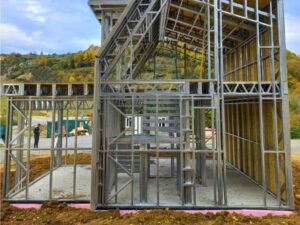
Introduction:
Steel construction relies on various types of steel members, each serving distinct purposes:
- Cold-formed Members: These are steel elements created from flat steel sheets or strips, which are cold-formed into desired shapes using press or bending brake processes. Cold-formed steel is known for its strength and versatility, making it ideal for a wide range of applications in construction.
- Hot-rolled Members: In contrast to cold-formed members, hot-rolled steel is shaped at high temperatures, resulting in different properties and shapes. Hot-rolled steel members are often used for structural purposes where high strength is required.
CSA S136-16 Standard: In Canada, the design of cold-formed steel members is governed by the CSA S136-16 standard, which provides guidelines and specifications for the design of cold-formed steel structural elements. This standard ensures that cold-formed steel structures meet the necessary safety and performance requirements.
Steel construction continues to evolve, with advancements in technology and materials leading to innovative solutions and structures that are both efficient and sustainable.
Advantages:
In today’s construction landscape, a plethora of materials are utilized, each offering unique advantages. Steel, in particular, boasts several key benefits:
Economical Advantages:
- Steel’s lightweight nature compared to alternatives like timber, concrete, and masonry reduces construction costs for lateral force resisting systems and foundations.
Design Flexibility:
- With access to design guides, software, and technical resources, steel offers designers a wide range of possibilities.
- Steel’s impressive strength-to-weight ratio, up to seven times greater than dimensional lumber, allows for innovative and versatile designs.
- Its consistent manufacturing process ensures high quality and adaptability.
Resilience and Sustainability:
- Steel comes with standard coatings such as galvanization/galvalume and can be further coated for harsh environmental conditions, offering excellent corrosion protection.
- Durability tests suggest that coatings can last over 100 years.
- It can withstand extreme cold weather conditions without requiring additional heating.
Environmental Sustainability:
- With an average of 25% recycled content and a recycling rate of over 90% at the end of its lifespan, steel is highly sustainable.
- Its dimensional stability allows for precise fabrication, minimizing on-site waste.
Fire Safety:
- ULC-rated designs are available to meet various building code requirements.
- Non-combustible steel reduces the risk of fire compared to wood construction.
- Structural tests show that steel maintains its strength and stiffness at high temperatures.
Panelization and Efficiency:
- Steel components, such as wall and floor panels for mid-rise buildings, can be factory-built for efficient mass production.
- Prefabricated steel components can be assembled in a controlled factory setting, reducing on-site construction time.
- Mobile cranes can be used for the erection of mid-rise steel buildings.
These advantages position steel as a versatile, durable, and sustainable material in modern construction, offering cost-effective and efficient solutions for a variety of projects.